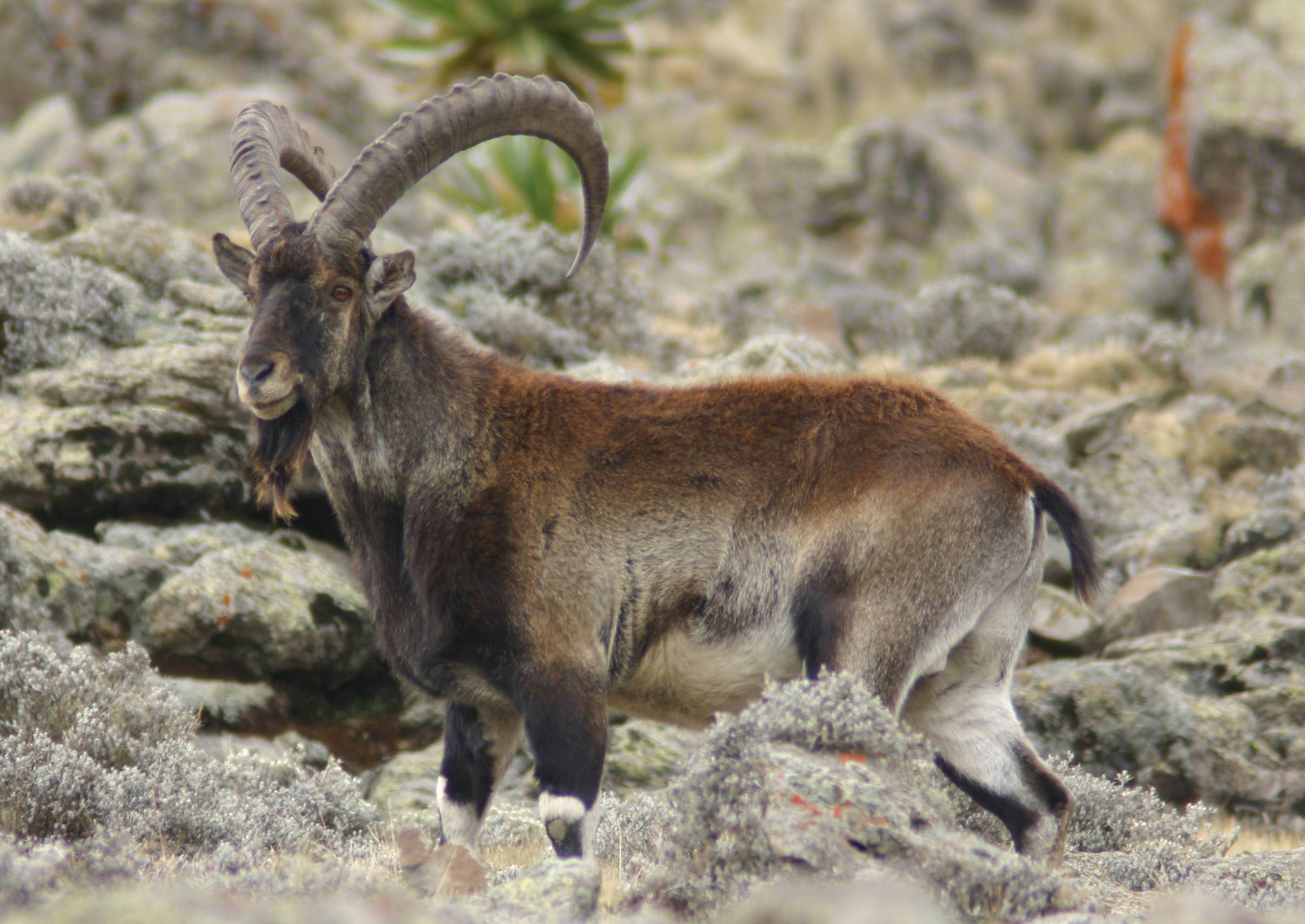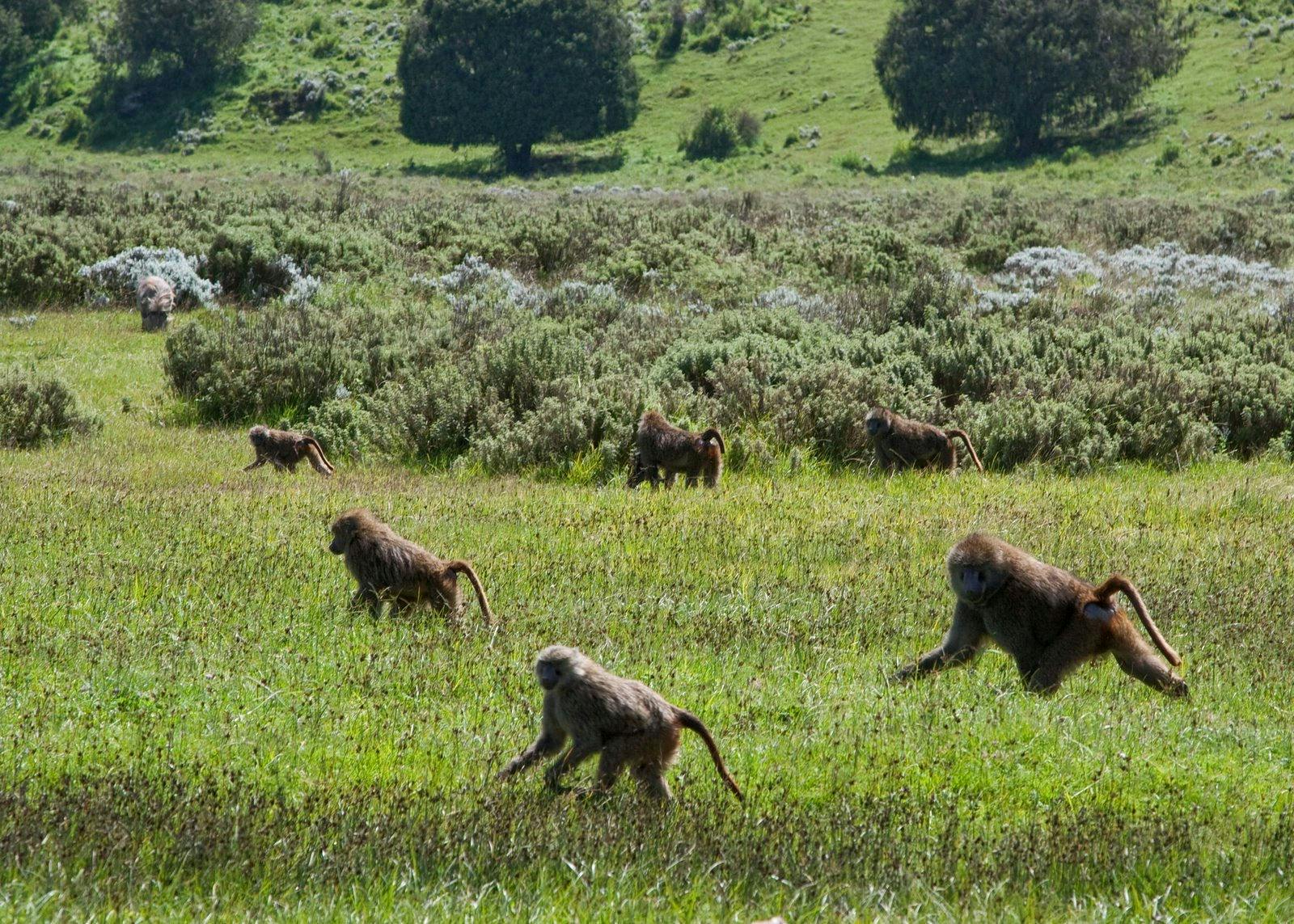Ethiopian Montane Grasslands and Woodlands
The ecoregion’s land area is provided in units of 1,000 hectares. The conservation target is the Global Safety Net (GSN1) area for the given ecoregion. The protection level indicates the percentage of the GSN goal that is currently protected on a scale of 0-10. N/A means data is not available at this time.
Bioregion: Lake Turkana-Sudd Grasslands, Bushlands & Forests (AT21)
Realm: Afrotropics
Subrealm: Horn of Africa
Ecoregion Size (1000 ha):
22,253
Ecoregion ID:
79
Conservation Target:
17%
Protection Level:
5
States: Ethiopia, Eritrea, Sudan
The endemic Walia Ibex, restricted to the Simien Mountains National Park in this ecoregion, has been the most endangered ungulate in the world for the past 50 years. It roams the Afromontane grasslands at nearly 3,500 m enduring temperatures ranging from below 0°C to above 25°C. Populations of the ibex have suffered decline due to habitat degradation from agricultural encroachment and livestock grazing, as well as from poaching. Today, it is threatened by hybridization with free-ranging domestic goats. Ibex populations were down to 200 individuals in 1996 but gradually increased up to 790 in 2011, which is primarily due to conservation efforts.

The walia ibex (Capra walie) is the flagship species of the Ethiopian Montane Grasslands and Woodlands ecoregion. Image credit: Leonard A. Floyd, Public Domain
The ecoregion is biologically rich and severely threatened. It covers the majority of two Ethiopian Mountain massifs ranging from 1,800 to 3,000 m in elevation, with montane forest at lower altitudes and Afroalpine habitat at higher altitudes. The climate of these highlands is greatly affected by their topography, and also by the movement of the Inter Tropical Convergence Zone (ITCZ). As the ITCZ moves north between May and October, warm moist air from the Indian Ocean brings rain to the southern slopes of the Ethiopian Highlands. During the remainder of the year, winds from the Red Sea typically contain less moisture, which mainly falls on the northern side of the highlands.
Overall, the highest annual rainfall (up to 2,500 mm) occurs on the southwestern faces of the highlands, which support montane or transitional forests, whereas average annual rainfall is closer to 1,600 mm over most of the ecoregion. The Ethiopian Highlands first began to rise in the Eocene 55 million years ago. The main dome was split into two halves, the northern and southern highlands, by the development of the Rift Valley during the Miocene, about 13 million years ago.
_male-CC-Charles%20J%20Sharo_resized.jpg)
Mountain nyala. Image credit: Charles J Sharo, Creative Commons
The natural vegetation was a mixture of closed forest in areas with higher rainfall, grassland, bushland, and thicket in other lower-rainfall areas. There is a cloud forest belt at 2,000–2,500 m in the south, whereas in drier locations the forest is dominated by Podocarpu falcatus, Juniperus procera, and Olea Africana. On the moist upper slopes of the Harenna Forest, a shrubby zone of Hageniz and Schefflera grows along with giant lobelias.
Phytogeographically, the ecoregion is part of the Afromontane archipelago-like regional center of endemism. The ecoregion contains a high number of endemic plants, with most endemics occupying open habitats. The high altitude regions of Ethiopia and Eritrea have a high diversity of mammals with near-endemic species, many shared with the Ethiopian Montane Moorlands ecoregion, such as the Walia ibex, mountain nyala, and gelada baboon.
An antelope commonly found at lower elevations is Menelik’s bushbuck, a subspecies endemic to Ethiopia. Two different subspecies of vervet monkey are found in this ecoregion: the Djam-djam or Bale monkey, which is restricted to the southern highlands, and the black-faced vervet.
_male-CC-Charles%20J%20Sharp-2017_resized.jpg)
Gelada. Image credit, Charles J Sharp, Creative Commons
The ecoregion covers the majority of the South and Central Ethiopian Highlands Endemic Bird Areas. Species include the strictly endemic lineated pytilia and the near-endemic Ruppell's chat and Ankober serin. The white-winged flufftail is a threatened species that occurs in this ecoregion. At least 10 amphibians are endemic or near-endemic to the ecoregion, including the strictly endemic grassland forest treefrog.
By the early 20th century, only 5% of the Ethiopian Highlands were forested, although it is believed that at one time forest covered most of the area. Less than 1% of these forests remain because Podocarpus and Juniperus provide the most commonly used timber in Ethiopia and have been intensively logged. The remaining grassland and thorn scrub patches are generally confined to rocky and steep areas. Besides these inaccessible areas, the only remaining forested areas are church graveyards.
_with_juvenile-Charles%20J%20Sharp-2016_resized.jpg)
Olive baboons. Image credit: Charles J Sharp, Creative Commons
Even these forests are not totally protected. Parts of the ecoregion are officially protected within the Bale and Simien Mountains National Park and National Forest Priority Areas including Kahatasa-Guangua and Munesa-Shashemene. Additionally, there are controlled hunting areas including Arsi and Maze as well as Yob Wildlife Reserve.
This ecoregion has been highly degraded due to agricultural encroachment, livestock overgrazing, and settlement expansion. Most of the population practices subsistence farming and the demand on natural products and land for farming is huge. This has been the case for many hundreds of years, and is the predominant reason for the widespread loss of natural vegetation.
Priority conservation actions for the next decade:
- Identify gaps in the ecological representation of the existing protected areas and establish protected areas to fill in these gaps.
- Rehabilitate degraded habitats and encourage the adoption of sustainable agricultural technologies.
- Support community-based conservation to maintain and increase Walia Ibex population numbers.
-
-
1. Burgess, N., Hales, J.A., Underwood, E., Dinerstein, E., Olson, D., Itoua, I., Schipper, J., Ricketts, T. and Newman, K. 2004. Terrestrial ecoregions of Africa and Madagascar: a conservation assessment. Island Press.
2. Ejigu, D., Bekele, A. and Powell, L. 2017. Walia ibex have increased in number and shifted their habitat range within Simien Mountains National Park, Ethiopia. Journal of Mountain Ecology. 10, pp. 27-44.
3. Government of the Federal Democratic Republic of Ethiopia. 2015. Ethiopia’s National Biodiversity Strategy and Action Plan 2015-2020. Addis Ababa, Ethiopia: Ethiopian Biodiversity Institute.
4. Asefa, A., Mengesha, G., Shimelis, A. and Mamo, Y. 2015. Livestock Grazing in afromontane grasslands in the Northern bale mountains, Ethiopia: Implications for bird conservation. Science, Technology and Arts Research Journal. 4(2), pp.112-121. -
Cite this page: Ethiopian Montane Grasslands and Woodlands. Ecoregion Snapshots: Descriptive Abstracts of the Terrestrial Ecoregions of the World, 2021. Developed by One Earth and RESOLVE. https://www.oneearth.org/ecoregions/ethiopian-montane-grasslands-and-woodlands/
-




